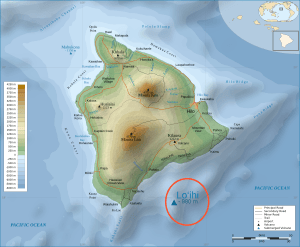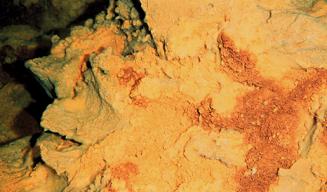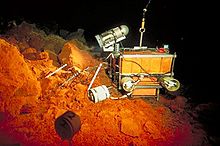Lōʻihi Seamount facts for kids
Quick facts for kids Lōʻihi Seamount |
|
|---|---|

Southeast of the island of Hawaiʻi, Hawaii, U.S.
|
|

Yellow iron oxide-covered lava rock on the flank of Lōʻihi
|
|
| Summit depth | 3,200 ft (975 m). |
| Height | over 10,000 ft (3,000 m) above the ocean floor |
| Summit area | Volume – 160 cu mi (670 km3) |
| Translation | "long" (from Hawaiian) |
| Location | |
| Location | Southeast of the island of Hawaiʻi, Hawaii, U.S. |
| Coordinates | 18°55′N 155°16′W / 18.92°N 155.27°W |
| Country | United States |
| Geology | |
| Type | Submarine volcano |
| Volcanic arc/chain | Hawaiian–Emperor seamount chain |
| Age of rock | At least 400,000 years old |
| Last eruption | February to August 1996 |
| History | |
| Discovery date | 1940 – US Coast and Geodetic Survey chart number 4115 |
| First visit | 1978 |
Lōʻihi Seamount (also known as Lōihi) is an active submarine volcano, meaning it's an underwater volcano. It's located about 35 km (22 mi) off the southeast coast of the island of Hawaii. The very top of Lōʻihi is about 975 m (3,200 ft) below the ocean's surface.
Lōʻihi sits on the side of Mauna Loa, which is the largest shield volcano on Earth. The name Lōʻihi means "long" in Hawaiian. It's the newest volcano in the Hawaiian–Emperor seamount chain, a long line of volcanoes stretching about 6,200 km (3,900 mi) northwest from Lōʻihi. Unlike most volcanoes in the Pacific Ocean, Lōʻihi formed from a hotspot deep in the Earth, far away from where Earth's plates meet.
Lōʻihi started forming around 400,000 years ago. Scientists believe it will rise above the sea and become an island in about 10,000 to 100,000 years. From the ocean floor, Lōʻihi Seamount is more than 3,000 m (10,000 ft) tall. That's taller than Mount St. Helens was before its big eruption in 1980! Many tiny living things, called microbes, live around Lōʻihi's hot water vents.
In the summer of 1996, Lōʻihi had a huge series of 4,070 earthquakes. This was the biggest earthquake swarm ever recorded in Hawaii at that time. The earthquakes changed about 10 to 13 km2 (4 to 5 sq mi) of the volcano's top. One area, called Pele's Vents, completely fell in and became Pele's Pit. The volcano has been active since then and is watched by the United States Geological Survey (USGS). Lōʻihi's last known eruption was in 1996, just before that big earthquake swarm.
Contents
What is Lōʻihi Like?
How Lōʻihi Formed
Lōʻihi is an underwater volcano that sits on the side of Mauna Loa, Earth's largest shield volcano. It's the newest volcano made by the Hawaiʻi hotspot in the long Hawaiian–Emperor seamount chain. Lōʻihi's top is about 80 km (50 mi) from Mauna Loa's top. This distance is also about how wide the Hawaiʻi hotspot is.
Lōʻihi has a top area with three pit craters, which are bowl-shaped hollows. It also has two long rift zones, which are cracks where lava can erupt. One rift zone goes north for 11 km (7 mi), and the other goes south-southeast for 19 km (12 mi).
The three craters at the top are called West Pit, East Pit, and Pele's Pit. Pele's Pit is the newest. It formed in July 1996 when an area called Pele's Vent, which had hot water vents, collapsed into a big hole. The walls of Pele's Pit are 200 m (700 ft) high. They are very thick, which suggests that lava has filled these craters many times before.
Lōʻihi's long shape, stretching north and south, is why it's called "Lōʻihi," meaning "long" in Hawaiian. The northern and southern rift zones don't have much dirt or sand covering them. This tells us that they have been active recently.
Before 1970, people thought Lōʻihi was an old, inactive volcano that had moved with the ocean floor. But in 1970, scientists studied a series of earthquakes near Hawaii. They found that Lōʻihi was actually an active part of the Hawaiian volcano chain.
Lōʻihi sits on the ocean floor, which slopes gently. Its northern base is 1,900 m (2,100 yd) below sea level, near Mauna Loa. But its southern base is much deeper, at 4,755 m (15,600 ft) below the surface. This means Lōʻihi is 931 m (3,054 ft) tall from its northern base, but a huge 3,786 m (12,421 ft) tall from its southern base.
Lōʻihi is growing in the same way all Hawaiian volcanoes do. Its lava shows that it's changing from a young, steep volcano to a wider, more active shield volcano. This helps scientists understand how Hawaiian volcanoes begin. Lōʻihi often has landslides because its sides are steep and unstable. These landslides are a normal part of how Hawaiian volcanoes grow in their early stages.
Growing Up: Lōʻihi's Age
Scientists use a method called Radiometric dating to figure out how old rocks from Lōʻihi are. The oldest rock found is about 300,000 years old. After the 1996 event, even younger rocks were collected. Based on these samples, scientists guess Lōʻihi is about 400,000 years old.
The volcano grows by about 3.5 mm (0.14 in) per year near its bottom and 7.8 mm (0.31 in) per year near its top. As Hawaiian volcanoes slowly drift northwest at about 10 cm (4 in) a year, Lōʻihi was 40 km (25 mi) southeast of its current spot when it first started erupting.
Is Lōʻihi Active?
Lōʻihi is a young and quite active volcano, though not as active as nearby Kīlauea. Over the past few decades, Lōʻihi has caused several earthquake swarms. These are times when many earthquakes happen in one area. Scientists have been recording its activity since 1959.
Most earthquake swarms at Lōʻihi last less than two days. The two biggest exceptions were a swarm in 1990-1991, which lasted several months, and the 1996 event, which was shorter but much stronger. During the 1996 event, a special sensor on the ocean floor helped scientists see that the earthquakes were happening deep inside the volcano, near where its magma chamber (a pool of molten rock) is. This proves that Lōʻihi's earthquakes are caused by volcanic activity.
Since 1959, Lōʻihi has had a low level of seismic activity, with two to ten earthquakes per month. But sometimes, there are big swarms with hundreds of earthquakes. Most of these earthquakes happen in the southwest part of Lōʻihi. The biggest recorded swarms were in 1971, 1972, 1975, 1991–92, and 1996.
The Big Shake: Lōʻihi's 1996 Earthquake
The most activity recorded for Lōʻihi was a huge swarm of 4,070 earthquakes. This happened between July 16 and August 9, 1996. It was the largest and strongest earthquake series ever recorded for any Hawaiian volcano at that time. Most of the earthquakes were small, but hundreds were stronger than magnitude 3.0, and over 40 were stronger than 4.0. One even reached magnitude 5.0.
Scientists quickly went to Lōʻihi in August 1996 to study the swarm. They used manned-submersibles (small submarines with people inside) to explore the area. They found fresh rocks, which showed that an eruption had happened before the earthquake swarm.
Later studies in September and October 1996 showed that the southern part of Lōʻihi's top had collapsed. This happened because of the earthquakes and magma moving away from the volcano. A new crater, 1 km (0.6 mi) wide and 300 m (330 yd) deep, formed from the broken rock. About 100 million cubic meters of volcanic material moved. An area of 10 to 13 km2 (3.9 to 5.0 sq mi) on the summit changed. It was covered in huge pillow lava blocks, some as big as buses. "Pele's Vents," an area that used to be stable, completely collapsed into a giant hole, which was renamed "Pele's Pit."
Researchers saw clouds of sulfur and other minerals. The collapse of Pele's Vents caused a huge release of hot, mineral-rich water. The minerals suggested the water was hotter than 250 °C (482 °F), which was a record for an underwater volcano. The materials were like those from "black smokers" found along mid-ocean ridges.
These studies showed that the most active areas for volcanoes and hot water vents were along the southern rift. A new hot water vent field, called Naha Vents, was found in the upper-south rift zone, at a depth of 1,325 m (1,449 yd).
Recent Rumblings
Lōʻihi has been mostly quiet since the 1996 event. No activity was recorded from 2002 to 2004. But in 2005, it showed signs of life again with an earthquake bigger than any before. The USGS reported two earthquakes, magnitudes 5.1 and 5.4, in May and July. Both came from deep within the Earth, at 44 km (27 mi).
In April, a magnitude 4.3 earthquake was recorded at about 33 km (21 mi) deep. From December 2005 to January 2006, about 100 earthquakes happened, with the largest being magnitude 4. Another earthquake, magnitude 4.7, was later recorded between Lōʻihi and Pāhala on the coast of Hawaii.
Exploring Lōʻihi
Early Discoveries
Lōʻihi Seamount first appeared on a map in 1940. It was just one of many underwater mountains. But in 1952, a large earthquake swarm drew attention to it. That same year, a geologist named Gordon A. MacDonald thought Lōʻihi might be an active underwater shield volcano, like Mauna Loa and Kīlauea. He believed it was the newest volcano in the Hawaiian chain, made by the Hawaiʻi hotspot.
For a while, Lōʻihi was mostly ignored. But in 1978, an expedition studied strong, repeated earthquakes around Lōʻihi. Instead of an old, dead seamount, they found that Lōʻihi was a young, possibly active volcano. They saw young and old lava flows covering the volcano. They also found hot water coming out of active vents.
In 1978, a US Geological Survey research ship collected rock samples and took pictures of Lōʻihi's top. The pictures and rock tests showed the material was "fresh," giving more proof that Lōʻihi is still active. More samples and photos in 1980-1981 confirmed this. Studies showed that eruptions came from the southern part of the rift crater, which is closest to the Hawaiʻi hotspot that feeds Lōʻihi with magma.
From 1996 to Today
Most of what we know about Lōʻihi comes from dives made after the 1996 eruption. During a dive right after the earthquakes, it was hard to see because of many minerals and large floating mats of bacteria in the water. These bacteria feed on the dissolved nutrients and had already started growing around the new hot water vents at Pele's Pit. Scientists collected them to study in the lab.
Scientists used special mapping tools to measure how Lōʻihi's summit changed after the 1996 collapse. They also checked the hot water plumes to see changes in their energy and dissolved minerals. The Pisces V submersible, from the Hawaiʻi Undersea Research Laboratory (HURL), allowed scientists to collect samples of the vent waters, tiny organisms, and mineral deposits.
Since 2006, a project called FeMO (Fe-Oxidizing Microbial Observatory) has sent ships to Lōʻihi every October. These trips study the many iron-oxidizing bacteria that live there. Lōʻihi's hot water vent system has a lot of CO2 and Iron, but not much sulfur. This creates a perfect home for iron-oxidizing bacteria, like Mariprofundus ferrooxydans.
HUGO: An Underwater Eye
In 1997, scientists from the University of Hawaiʻi put an ocean bottom observatory on Lōʻihi Seamount's top. They called it HUGO (Hawaiʻi Undersea Geological Observatory). HUGO was connected to the shore, 34 km (21 mi) away, by a fiber optic cable. It was designed to send scientists real-time information about Lōʻihi, including earthquake data, chemical readings, and pictures. This made Lōʻihi an international lab for studying underwater volcanoes.
However, the cable that powered HUGO broke in April 1998, shutting it down. The observatory was brought back up from the seafloor in 2002.
Life Around Lōʻihi
Hot Vents and Tiny Life
Lōʻihi's location in the middle of the Pacific Ocean and its steady system of hot water vents create a rich home for a tiny living world. Many active hot water vents are found on Lōʻihi's crater floor, its northern slope, and along its summit. These vents were first found in the late 1980s. They are very similar to those found at mid-ocean ridges, with similar hot water and minerals.
The two main vent areas at the top are Pele's Pit (formerly Pele's Vents) and Kapo's Vents. They are named after the Hawaiian deity Pele and her sister Kapo. These vents used to be "low temperature vents" with water around 30 °C (86 °F). But the 1996 eruption and the creation of Pele's Pit changed this, making the water much hotter, up to 77 °C (171 °F) in 1996.
The vents are located 1,100 to 1,325 m (3,609 to 4,347 ft) below the surface, and their temperatures range from 10 to over 200 °C (392 °F). The water from the vents has a lot of CO2 and Iron, but not much sulfur. Low oxygen and pH levels also help support the high amounts of iron, which is a special feature of Lōʻihi. These conditions are perfect for iron-oxidizing bacteria, called FeOB, to grow. One example is Mariprofundus ferrooxydans.
A wide variety of microbial mats (layers of tiny living things) surround the vents and almost cover Pele's Pit. The Hawaii Undersea Research Laboratory (HURL) and NOAA study these hot water systems and the tiny life forms that live there. In 1999, scientists collected samples of extremophiles (organisms that live in extreme conditions) from Lōʻihi. They found a new jelly-like organism around the 160 °C (320 °F) vents.
Bigger Animals
The larger marine life around Lōʻihi is not as varied as at other, less active seamounts. Fish found near Lōʻihi include the Celebes monkfish and members of the Cutthroat eel family.
Invertebrates (animals without backbones) found here include two species that live only in these hot water vents: a type of shrimp (Opaepele loihi) and a tube worm. After the 1996 earthquake swarms, scientists couldn't find these shrimp or worms. It's not known if the big changes affected these species permanently.
From 1982 to 1992, researchers used submersibles to photograph fish around Lōʻihi Seamount and other areas. They found a few species at Lōʻihi that had never been seen in Hawaii before, like the Tassled coffinfish and the Celebes monkfish.
See also
 In Spanish: Lōʻihi para niños
In Spanish: Lōʻihi para niños



